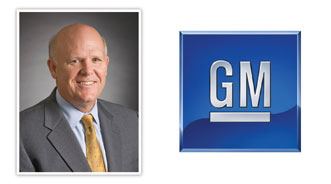GM Achieves Profitable 2010, but Chief Says More Work Ahead

Reflecting on General Motors’ first full year of operations after emerging from bankruptcy as a new company, chairman and chief executive officer Dan Akerson touted the “good start” that 2010 represented with net income approaching $5 billion — GM’s first profitable year since 2006 — and revenues exceeding $135 billion
But he also stressed that GM has a ways to go and outlined what the automaker has planned for 2011.
Overall, GM’s annual net income during 2010 was $4.7 billion with revenue coming in at $135.6 billion.
“In summary, good start, a lot more work to do,” Akerson said during a conference call Thursday, referring to the recently completed fiscal year.
“2010 was clearly a good year for General Motors,” he added. “I’m not sure anyone would have predicted a year ago that GM would have delivered net income of $4.7 billion and automotive free cash of $6.4 billion before contributing $4 billion to the U.S. pension plan.
“In addition, (GM saw) four consecutive quarters of positive EBIT and automotive cash flow excluding the pension contribution,” he noted.
As far as 2011, Akerson boiled down GM’s focus to four key areas.
The first goal is to “continue to develop and launch great products for our customers around the world on a consistent basis.”
Second, Akerson stressed that GM “must drive for improved business results around the world.”
“This includes strengthening our position in emerging markets like China and Brazil, implementing and following through on our restructuring plan in Europe and continuing to leverage industry growth in North America," he emphasized.
Moving on to the next goal, Akerson said that GM will focus on bolstering technology.
“I believe we are in for a sea change in this area and I also believe GM can and will lead,” he noted.
The fourth area Akerson touched on was in regards to GM’s balance sheet. He felt the automaker “made great progress” last year and anticipates further strides this year.
“We are on a journey to minimalize debt and fully funding and de-risking our U.S. pension plan,” Akerson commented. “And I will expect we will make meaningful steps in that direction in 2011.”
Fourth-Quarter Results
GM’s fourth-quarter net income was $500 million, with revenue coming in at $36.9 billion.
The net income includes $400 million in net charges. GM attributed that to a loss of $700 million from the repurchase of U.S. Treasury preferred shares, which the impact of EBIT adjustments partially counteracted.
“The company had approximately $0.3 billion in favorable EBIT adjustments including the previously disclosed $0.2 billion gain associated with the repayment of the VEBA Note, and $0.1 billion of cumulative gains on the sale of Nexteer and the purchase of the Strasbourg, France facility,” the automaker said.
Overall, EBIT was at $1 billion during the quarter.
Breaking down the quarter further, GM North America’s quarterly EBIT was $800 million, up from a $3.4 million loss in the prior-year period.
GM Europe incurred a $600 billion loss before interest and taxes, which is stronger than the year-ago period, when it lost $800 million. Meanwhile GM International Operations posted fourth-quarter EBIT of $300 million, versus $400 million in the prior-year period.
GM South America’s EBIT totaled $200 million during the fourth quarter. In the fourth quarter of 2009, it was at $300 million. GM noted that it started reporting this region’s results during the fourth quarter and has revised prior period’s reporting as such.
Moving on to other fourth-quarter results for GM, automotive net cash flow from operating activities came in at negative $1.7 billion. This sum accounts for the $4 billion cash GM contributed to its U.S. pension plan.
Automotive free cash was at negative $2.8 billion. This accounts for a deduction of $1.1 billion in capital expenditures.
Profit Sharing, More
GM also revealed Thursday that about 45,000 eligible U.S. hourly employees and about 3,000 eligible GM Components Holdings employees will be given profiting sharing, thanks to GM’s robust 2010.
In addition, GM announced that after assessing remediation actions that it put in place to address the company’s material weakness regarding the financial reporting process, the management team and Audit Committee of the Board of Directors concluded that the material weakness no longer exists as of Dec. 31, 2010.
“Our focus for 2011 is to build on our progress and continue to generate momentum in the marketplace. We expect our first quarter will be a strong start,” stated Chris Liddell, GM’s vice chairman and chief financial officer.
Analysts Offer Reaction to GM’s First Year
GM’s year seems to have generated some mixed reaction in the automotive analyst community.
One site, TrueCar.com, emphasized that this was the automaker’s first annual profit in six years. The site attributed some of the automaker’s strength to decreased incentives and higher transaction prices. Specifically, the average transaction price for GM climbed 7 percent year-over-year to $34,149. Incentives for the automaker dropped 5.3 percent year-over-year to $3,397 per vehicle.
“This has been a remarkable year for GM following their emergence from bankruptcy,” said Jesse Toprak, TrueCar’s vice president of industry trends and insights. “Their recovery has been fueled by significant cost-cutting, arrival of new products that consumers were seeking along with better management of incentives and supply.”
He added: “The sky is the limit for GM after becoming profitable at this low of a sales pace," added Toprak.”
Over at Edmunds.com, senior analyst Michelle Krebs had a different take.
“GM certainly deserves credit for turning things around, but the full picture isn’t entirely rosy. While GM had all four quarters of 2010 in the black, the fourth quarter was its weakest of the year,” she said.
“Also, Edmunds.com’s sales forecast has GM spending lots of money on incentives just to cling to market share, which adds up to lousy per-vehicle profits,” Krebs continued. “Based on GM’s stock activity so far today, it looks like Wall Street is cautious, too.”

 View The Latest Edition
View The Latest Edition

